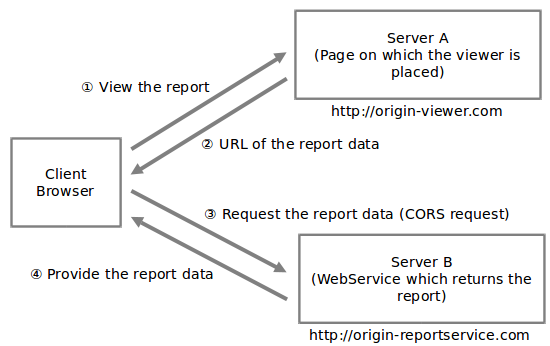Cross-Origin Resource Sharing is a technology for the web that provides async web operations to directly access reports from different domains. CORS works by adding a special header to responses from a server to the client. If a response contains the Access-Control-Allow-Origin header, then you can directly access the reports from another domain.

The following viewers require CORS:
If Server is an ASP.NET application, then following markup should be added to the web.config file:
| web.config |
Copy Code
|
|---|---|
<customHeaders>
<add name="Access-Control-Allow-Origin" value="http://localhost:44362" />
<add name="Access-Control-Allow-Methods" value="GET, POST, OPTIONS" />
<add name="Access-Control-Allow-Credentials" value="true"/>
<add name="Access-Control-Allow-Headers" value="pragma,cache-control,expires,content-type"/>
<add name="Access-Control-Expose-Headers" value="Content-Disposition"/>
</customHeaders>
|
|
Replace the "http://localhost:44362" with the actual client url.
If Server is an ASP.NET Core application,
1. Add the following code to the Startup.ConfigureServices method in Startup.cs file:
| Startup.cs |
Copy Code
|
|---|---|
public void ConfigureServices(IServiceCollection services) { services .AddLogging(config => { config.ClearProviders(); if (Environment.GetEnvironmentVariable("ASPNETCORE_ENVIRONMENT") == Environments.Development) { config.AddConsole(); } }) .AddCors(options => { options.AddPolicy("AllowAll", builder => { builder.SetIsOriginAllowed(origin => new Uri(origin).Host == "XXXX") .AllowCredentials() .AllowAnyMethod() .AllowAnyHeader() .WithExposedHeaders("Content-Disposition"); }); }) .AddReportViewer() .AddMvc(option => option.EnableEndpointRouting = false); } |
|
2. Add the following code to the Startup.Configure method in Startup.cs file:
| Startup.cs |
Copy Code
|
|---|---|
public void Configure(IApplicationBuilder app, IWebHostEnvironment env) { if (env.IsDevelopment()) { app.UseDeveloperExceptionPage(); } app.UseCors("AllowAll"); app.UseReportViewer(settings => { settings.UseEmbeddedTemplates(EmbeddedReportsPrefix, Assembly.GetAssembly(GetType())); settings.UseCompression = true; }); app.UseMvc(); } |
|